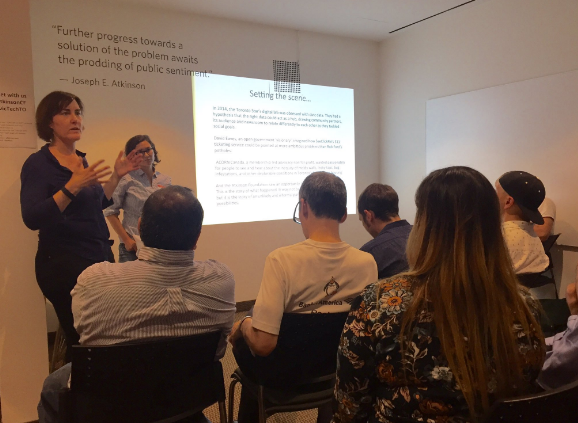
Since 2014, Jennifer Hollett has been our Atkinson Associate on Civic Technology. She was recently appointed the Head of News and Government at Twitter Canada. This is her farewell post.
“How many of you work in tech?”
It’s International Women’s Day and I’m hosting a panel on women in tech, with … women in tech. As I try to get a sense of who is in the audience, most hands go up. I then ask those who didn’t raise their hands, what fields they work in. One woman says, “Don’t we all really work in tech? Technology runs through our lives in so many ways.”
So true, the room collectively nods and we continue the discussion as if everyone is working in tech. Technology, as defined by Merriam-Webster, is “the use of science in industry, engineering, etc., to invent useful things or to solve problems.” The rise of computer technology over the last two decades has brought technology to our fingertips, changing the way meet people, communicate with each other, buy products, and run businesses. Yet if you step into a city hall, provincial legislature, or political campaign office, you might think “because it’s 1998?”
With a new generation of digital natives, more and more people are looking to technology as they figure out how to get more involved in making the world a better place. Civic tech is an umbrella term for this movement. People and groups using technology to engage the public in improving their communities, government and the public good. This could be opening up government data and documents (called open data/open gov), making public services more accessible through an app or website, or creating a startup connected to civic issues or politics.
In 2014, I authored a primer on all of this, titled Civic Tech for Civic Voice. The Atkinson Foundation invited me to join them as an Associate on Civic Technology as they explored this emerging space. In my research, informal hackathons, and many one-on-one meetings, I discovered there was much interest, but a digital divide between those with tech skills and expertise (who I named with respect, the geeks), those in the non-profit or government sector (agent of change), and a few of us in between (the hybrids). The primer was an introduction, inviting more people to the movement, by introducing terminology and case studies at a time when many are still quick to dismiss the reach of a hashtag (despite reframing issues) or the impact of an app (look to the Uber/taxi debate).
In July, Atkinson partnered with Civic Tech Toronto to host four hacknights. This is a weekly event where technologists, developers, policy wonks, journalists, and students come together to meet new people and collaborate. There’s 50+ people on any given week, which impressive considering how hard it is to get three friends together for dinner. It’s a diverse group, who show up to volunteer their time to improve Toronto. It’s incredibly engaging. Working with Atkinson in this space for the last two and a half years, there are some great lessons from the civic tech movement that can benefit social justice movements at large.
All are welcome
A core principle of civic tech is that the more diverse, the stronger the movement. This applies to age, gender, race, class, as well as skill set and interest. Civic Tech Toronto looks like Toronto. They have achieved this by actively creating hacknights that build community: starting every meetup with their Code of Conduct and Anti-Harassment Policy, introductions from everyone in the room (even if there’s 70 people), and a Civic Tech 101 breakout session for anyone new or looking to learn more.
Share and study success
Each hack night, Civic Tech Toronto invites a guest speaker, someone working with civic tech, be it in health care or housing, as a hack or hacker. I spoke one evening about our Civic Tech for Civic Voice paper and how we can open up civic tech to more people. The presentation and Q&A is a great way to learn from those in the space, what’s working and even, what’s not.
Create space
The most fascinating part of the weekly hacknights is how people, strangers, come together to make something. Each hack carves out an hour and half for people to team up and create. People stand up and share ideas on what they’re hoping to work on that evening, then folks break out into groups and start brainstorming, building, coding, mapping. A similar space also exists online, with a very active Slack group.
If we’re all working in technology these days, how can technology help foundations like Atkinson and our partners in the fight for social and economic justice? That’s essentially what civic tech activists are doing.
